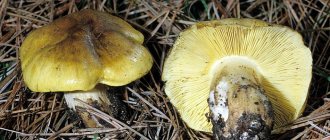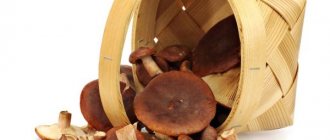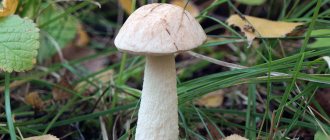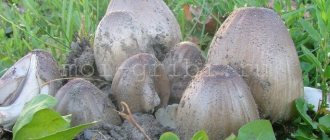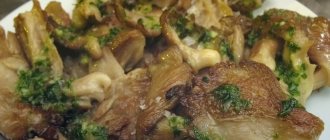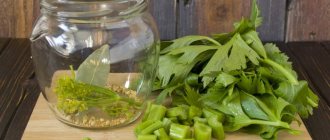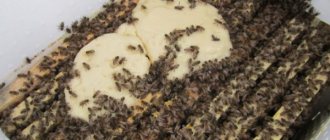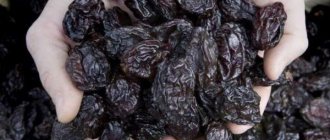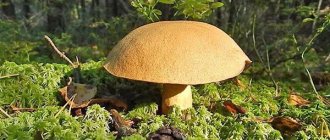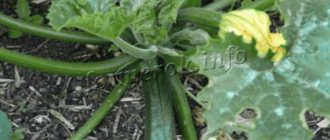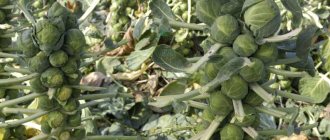» Mushrooms » Edible mushrooms » Ringed cap mushroom: how not to confuse it with its poisonous counterpart
0
1614
Article rating
You look at the ringed cap mushroom and turn away or even kick it: it looks so much like a poisonous one. Inexperienced mushroom pickers often ignore it. And in vain! After all, he has extraordinary taste. It is suitable for preparations, soups and frying. In many European countries it is considered a delicacy.
- Benefits and harms
- Where do they grow and when to collect?
- Primary processing and preparation
- Mushroom soup
- Pickling
- Pickling
- Similar species and how to distinguish
Mushroom cap ringed
Description and photo of the ringed cap
Most often it can be found growing next to blueberries, birch, beech, shrubs and berries. The mushroom is common in Europe, America, Japan, and also in Russia. From Latin - Cortinarius
caperatus.
Important! It’s interesting, but true, it was found even in Lapland at an altitude of 2000 m above sea level.
What other interesting things should a mushroom picker know about this representative of the Agaricomycetes class?
hat
Rosites dullus acquired its name due to its unique cap. In shape it resembles a small peculiar bell, slightly pointed at the top and smoothly descending down.
This mushroom is very similar to a member of the cobweb family. The hat has a rusty brown tint. Depending on the age of the mushroom, as well as on the conditions of its growth, the shade of brown may vary. The cap is fleshy and edible. When cut, no yellow coating is formed; the flesh remains white or beige for a long time. Under the cap there are thin stripes that separate future spores from each other.
If the mushroom is not successfully located in an area that is too illuminated, then the cap from abundant sunlight may become covered with microcracks and scratches, become dry, and become covered with scales.
A mushroom that is found in a cool, damp forest environment, on the other hand, has a rather slimy, glossy cap surface. As for the spore powder, it falls off at the end of August, at the beginning of September. Has a rusty brown tint.
The cap of young mushrooms itself reaches a diameter of 4 to 10 cm. The younger the mushroom, the more ovoid and spherical the shape of the cap is provided.
Leg
The stem of this mushroom resembles a column. It does not expand or thicken towards the base, and does not narrow towards the place where the cap is attached. It has a white or grayish tint depending on age. In girth from 1 cm to 3, depending on the age of the mushroom.
When cut, the stem is white in color, and even if it interacts with oxygen, it in no way loses its true color.
Most often, in the center of the leg there is a kind of skirt that catches spores falling from under the cap. The stem also refers to the edible elements of the mushroom. It is tightly attached to the mycelium cap. Young mushrooms have more bluish stems. In dry weather and excessive sun exposure, the substrate can become dry and brittle. Its taste is pronounced, mushroom.
Edibility
Mushrooms are edible. At the same time, you can use both its cap and its leg for food. The greatest taste and benefit can be obtained if you collect rosites in late August - early September.
You should not collect mushrooms that have external defects. The Ringed Cap is very fond of worms, which are also found in the humid environment of deciduous forests. If they begin to penetrate the cap or the stem, then rotting processes begin. The mushroom releases harmful substances that will not be beneficial to humans. Therefore, a mushroom with traces of damage should be left in place.
Also, a mushroom that has been exposed to direct sunlight for a long time becomes inedible. Now there are cracks in his cap and he is dry. There is nothing useful in this mushroom; moreover, it can also secrete substances that are not the most useful for consumption.
Already at the end of September, the mushroom becomes inedible, loses its taste properties, and its stem and cap gradually begin to turn into a slippery jelly-like mass.
Where does it grow and when to collect
The mushroom can easily be found in Russia. In addition, it has become widespread throughout the European part of the continent. You can find it in Poland, the Baltic countries, Germany, France and so on.
The ringed cap is also found in North America, where it received the name “swamp” due to its close location to similar places. In Japan, the mushroom was called "Turkish mushroom" because of the strange associations it has with the inhabitants of southern Europe.
Also, it was found in both Lapland and Greenland. Rosites prefers mainly deciduous forests, however, it can also be found among coniferous thickets. Loves moderate humidity and diffused light. Settles near bodies of water.
Does not like open glades, grows mainly in the shade. However, if for some reason direct sunlight begins to fall on it, it quickly fades and loses its edible properties.
It is recommended to collect this mushroom from late August to mid-September. From September to August, this mushroom already loses its taste properties and quickly dries out due to a lack of nutrients in the soil.
However, if the autumn turns out to be warm, there is a chance that your mushroom picking will be successful.
What does it look like
The cap of the ringed cap varies from 5 to 15 cm in diameter. The small mushroom's cap is shaped like an egg, but as it grows, it straightens into a hemispherical shape with edges curved inward. It can be gray-yellow, straw-yellow or ocher in color. It has a wrinkled surface and often cracks.
Did you know? There are so many varieties of mushrooms on our planet that scientists still cannot give an exact figure. It is believed that for one plant species there are about 6 species of mushrooms.
The plates are not too thick, have a yellowish or light brown color in a young mushroom and change it to brown-ocher as it matures.
The leg of the cap is white, sometimes yellowish above the mushroom ring. The length varies from 2 to 12 cm. The upper part of the leg has pronounced yellowish scales. The spore sac is rusty brown to ocher in color. Spores are 12 by 8 microns, ocher in color.
We invite you to familiarize yourself with Mushrooms in a deciduous forest in autumn
In order not to confuse these edible “gifts of the forest” with poisonous ones, you need to have a good idea of what the marshlands look like. The cap of the swamp moth is round, ovoid or almost spherical in shape. Its color is pinkish with a brown tint, very similar to a chicken egg shell placed on a leg. The diameter of the cap of a young mushroom is up to 4-4.5 cm; in old mushrooms it can reach 9-11 cm.
The surface of the cap is covered with wrinkles and a light-colored coating similar to flour
With age, the shape of the cap changes: in the center it becomes more convex, so it is often compared to a wide-shaped cap. The edges of the cap of young chickens, which are attached to the upper end of the leg, move apart over time, and the film breaks. And in the upper part of the leg a frill is formed, the edges of which are torn and lowered down.
On the reverse side of the cap, plates are visible on which spores of this fungus begin to grow over time. In young fruiting bodies, the color of the plates is white or yellowish. But the older the chickens, the darker the color of the plates becomes. After the cap opens, they become yellow, and after the spores mature, the plates acquire a rusty color.
Similar species
The annular cap is very similar to some species of vole mushrooms. Their fruiting bodies also have similar elements. The cap is usually light brown in color, and the surface is dry and glossy. These mushrooms have a white stem, however, as they age, they begin to darken.
Mushrooms mostly grow without a skirt, but it is still found on some specimens. The spore powder is gray-brown, less often purple-brown. The cap very much resembles the bell-shaped bentgrass, the early bentgrass, and also the stop-shaped agrocybe.
Early bent grass is a mushroom that has a cap 8 cm wide. In youth it is more spherical, but closer to an impressive age for a mushroom it becomes bell-shaped.
Just like Rosites dullus, it prefers cool deciduous forests with moderate humidity. But the hard field worker repeats the ringed cap only in part. It also has a skirt with legs, and the color is brown. However, the shape of the cap is not a cap, but more trampled.
However, inexperienced mushroom pickers mistake it for a cap, and therefore try to use it for food. But the hard field mushroom, although an edible mushroom, is not the most suitable for food. Young mushrooms have a bluish tint and a somewhat rough surface. However, with age, the color changes and becomes closer to rosites.
Might be interesting - Amanita strobiliformis: a very rare species of fly agaric.
Find out can't be confused
A young cap, grown in comfortable conditions, is an extremely recognizable mushroom. Hemispherical cap, tightly covering the leg, delicate pearlescent coating on a grayish or beige surface; Having carefully cut the mushroom, you can find a thick light gray blanket, a prototype of the ring. It is not for nothing that this mushroom was considered one of a kind for a long time.
Yesterday's cap (photo by user Gregory)
Inexorable time quickly takes its toll. The cap opens, retaining some kind of “filthy” tubercle in the center, and the edges become unpleasantly wrinkled, as if it were some kind of fiber. Rain and sun complete the metamorphosis: the delicate mother-of-pearl coating is washed off, and the cap itself is chaotically deformed, protruding wavy plates. At this point, the cap begins to look like a whole bunch of old mushrooms. There are known cases when some unidentified fly agaric mushrooms of the same age were collected mixed with old caps. I hope at least gray-pink.
Medicinal properties and medicine
Among the people, healers called the cap “chicken mushroom”. Not so much because of the appearance, but because of the taste properties that appear after cooking. Indeed, the mushroom was used to make medicinal decoctions.
However, in today's modern Russia, the healing properties of the ringed cap are little known. However, among our neighbors, in Belarus, this mushroom is very common. It is used as a medicinal component for a number of serious diseases.
Very often it is used as a compress for enlarged lymph nodes and other tonsillitis diseases.
If the mushrooms have been dried, they are carefully mixed with honey and lard and then applied to the swollen parts of the body that are inflamed.
In the Baltics, this mushroom is also widely used for its medicinal properties. For example, they make a decoction of mushrooms. To do this, the ringed cap is collected in an amount of 500 g and placed in a three-liter pan. Boil for several hours, then strain thoroughly. This decoction is used to treat the kidneys and also help remove stones from the body.
In Poland, it is believed that the brine that remains after these mushrooms is an ideal hangover reliever, even better than medications. This solution is also used to rub swollen limbs and make compresses.
However, if we think more intelligently and turn to scientific medicine, then, unfortunately, we will not find any mention of the fact that the mushroom has truly healing properties. Moreover, Rosites is not included as a healing component in any composition of medications, which also speaks volumes about its importance for medicine.
How to cook delicious chicken
The ringed cap is classified by many mushroom pickers as a gourmet mushroom, whose taste qualities are not inferior to the famous and most “noble” varieties. Such mushrooms can be harvested for future use or used to prepare first and second courses. It must be remembered that mushroom preparations must be stored in a cool basement or refrigerator at a constant temperature of 0-6°C.
Also read: What do graylings and greenfinches look like and where do they grow?
Pickling
Peel the fruiting bodies, separate the caps and cut into two or four pieces. Prepare a marinade from a liter of water, half a glass of 9% table vinegar, three cloves, one bay leaf, eight black pepper, 70 g granulated sugar and 30 g salt. Place the mushrooms in boiling water and boil for a quarter of an hour, then quickly cool in running water. Cold mushrooms are dipped into a boiling marinade, and after a couple of minutes they are placed in hot and sterilized glass jars, which are rolled up with lids.
For the preparation of all kinds of mushroom dishes, only mushroom caps of the white boletus are used.
Pickling
Rinse thoroughly in running water and boil the mushroom caps for a quarter of an hour, then quickly cool under running water and salt in layers using coarse rock salt. The standard salt consumption is approximately 350-370 g per bucket. It is allowed to top the pickled mushrooms with black currant and horseradish leaves. Oppression is installed on top. With this method of salting, the chickens are ready for consumption in about a month and a half. It is best to store fully prepared salted mushrooms in the basement or in a regular household refrigerator.
Clear and aromatic mushroom soup
After washing in running water, small mushroom caps are cut in half or into four parts, and larger ones are cut into fairly small pieces. Then you need to cut the onions, parsley root and carrots into slices, then boil them in water until half cooked.
Use in food
The ringed cap has a very delicate taste and aroma. That is why it is ideal for frying, boiling, salting and pickling.
However, there are very few recipes on the Internet that are dedicated specifically to this species of the Agaricomycetes family. In fact, all the standard recipes provided for honey mushrooms and chanterelles can also be applied to the ringed cap. However, it works best as a seasoning.
The mushroom has a subtle aroma that is similar to boiled chicken. Therefore, if you managed to collect a decent amount of mushrooms, while the bright sun is shining, place them on a special tray and leave them to dry.
Dried mushrooms can be obtained by exposure to the oven. To do this, you need to heat it to 70 degrees, and, closing the door loosely, wait until the mushrooms become dry.
Leave dried mushrooms in a dark, dry room for several days. After this, grind in a coffee grinder until it becomes a powder. It makes an excellent seasoning that can be added to soups and other dishes.
Video recipe
How to cook
Rosites dullus can be mixed with vegetables and baked in a sleeve. It turns out to be a very tasty dish. Ideal companions would be potatoes, eggplant, carrots, onions, and zucchini. All ingredients must be well prepared and cut into cubes. But the ringed cap can be cut in half or used as a whole.
Everything needs to be well salted, peppered and seasoned with sunflower oil. Add your favorite seasonings if necessary. Place the entire mixture in a baking sleeve, tie on both sides and place in the oven, after making a few cuts. The aroma will appear after 10-15 minutes, and a delicious dinner will be ready in an hour.
It is possible to pickle and pickle such mushrooms, however, given their relatively small size, as well as the small quantity when found (and these mushrooms actually grow dispersed and it is unrealistic to collect a whole basket), it is still better to abandon this idea. It is unlikely that you will be able to assemble a jar, so use these mushrooms fresh. This way they are much tastier and healthier.
Chicken marinated mushrooms recipe for the winter
Housewives often make vegetable and fruit preparations for the winter. But mushrooms do not go unnoticed. They can be salted, frozen and pickled. The marinating recipes are especially interesting.
Using this method, mushrooms are not only preserved for at least six months, but can also be used later to prepare various dishes - from first dishes to appetizers.
They are also good as an independent snack for the holiday table.
One of the varieties that can be marinated is chicken. Recipe for marinated chicken mushrooms Many mushroom pickers do not really value them, but this is not justified: they are edible, grow in large groups, and taste as good as champignons.
Also on our website you can find recipes on how to pickle boletus mushrooms so that your whole family will like them.
A little about “chickens”...
Chickens, also known as Ringed Caps, are an edible variety of mushroom that grows in places with high humidity from August to October. It is a mushroom with dense flesh, a bell-shaped cap of a light yellow or pinkish hue.
Quite popular for pickling and salting. Chickens are also known as Turks, white marshworts, and dull rosites. The taste is similar to champignons; young mushrooms are especially tasty.
In some European countries it is considered a delicious mushroom.
Marinated chicken for the winter
Note! It is believed that the most delicious part of a chicken is the cap - tender and aromatic flesh. In addition, there is a risk of finding insects in the legs. Chickens, like any other mushrooms, are not recommended to be mixed with other varieties when pickling
But when preparing soup or salad, you can use different mushrooms. Why can’t you marinate several types together? This is because some varieties of mushrooms have their own cooking nuances. And if you cook them together, the seaming can go bad very quickly.
Let's look at several options for preparing white botanicals.
Ingredients for cooking:
- chickens - 1 kg;
- water - 0.7 l;
- vinegar 9% - 2/3 of a regular glass;
- table salt - 1 tbsp. l.;
- sugar - 1 tsp;
- laurel - 1-2 leaves;
- citric acid - 5 g.
- Pour water into a saucepan. It is recommended to use a container with an enamel coating; aluminum cannot be used.
- Add salt, sugar and vinegar.
- As soon as the marinade boils, reduce the heat. Add pre-prepared chicken, bay leaves and cook for 15 minutes. During cooking, foam will appear on the surface. It must be collected with a slotted spoon and thrown away, otherwise the marinade will be cloudy.
- After 15 minutes of cooking the mushrooms, add acid and turn off the heat.
- Leave the mushrooms in the marinade to cool.
- Sterilize the jars.
- Place the mushrooms in jars and pour in the marinade. Roll up tightly.
The caps prepared using this method acquire a pleasant smell of spices.
Ingredients:
- ordinary water - 1.5 liters;
- marsh mushrooms - 1 kg;
- salt - 2 1/4 tbsp. spoons;
- pepper - 6 peas;
- cloves - 1 bud;
- bay leaf - 1 piece;
- citric acid - gram;
- vinegar 9% - 1/3 cup.
- Cooking begins with boiling the mushrooms.
- Pour water into a saucepan and heat.
- As soon as the water boils, add 2 tablespoons of salt and stir well.
- Peel and wash the mushrooms.
- Place the chickens in a container; when the water boils again, reduce the heat.
- Cook for 20 minutes, then pour out the liquid and leave the mushrooms to drain in a colander.
- Sterilize jars and lids.
- When the liquid has drained, place it in a container.
- While the mushrooms are draining, prepare the marinade.
- Pour 0.5 liters of water into an enamel container and place it on the stove over high heat to boil faster.
- Add 1/4 tablespoon of salt, all the spices and acid to the water.
- Boil the entire composition for 25 minutes. Then turn off the stove.
- Pour vinegar into the marinade. Leave to infuse for 15 minutes.
- Pour the marinade into jars with pre-packed mushrooms.
- Seal tightly and cover with a towel. When it cools down, place it in an unlit place with a temperature of 6 to 10 degrees.
For thrifty housewives, we have also prepared recipes for pickled squash, which will not only decorate your dining table, but will also be a wonderful and tasty addition to your dinner.
The chickens turn out sweet and spicy, while maintaining their own flavor.
